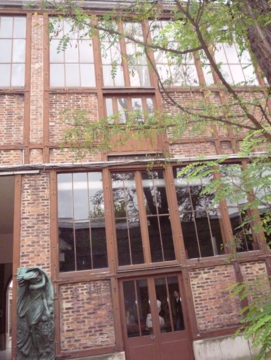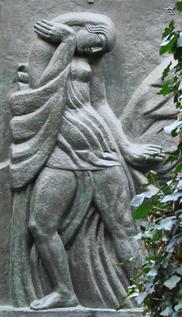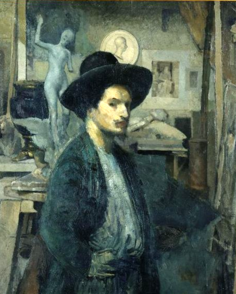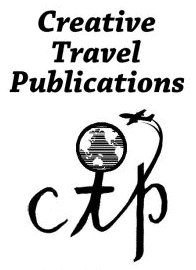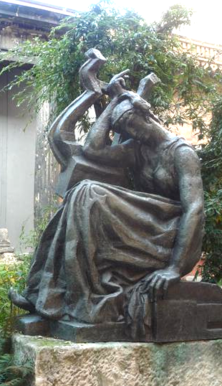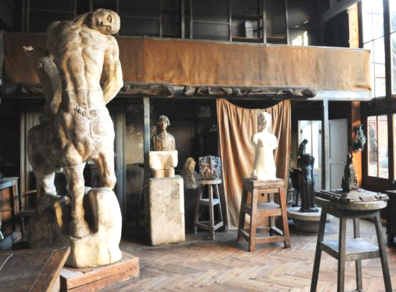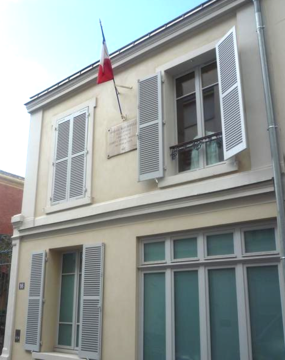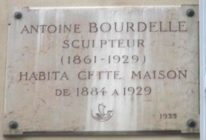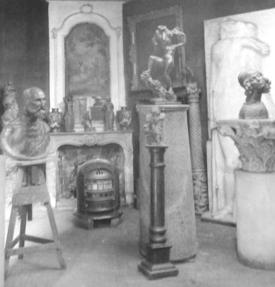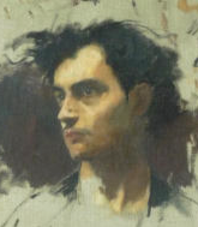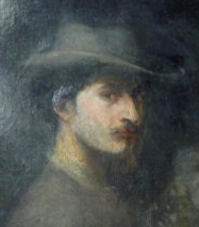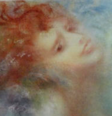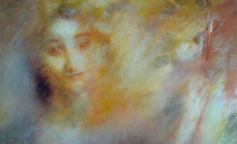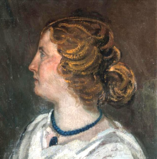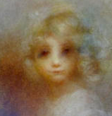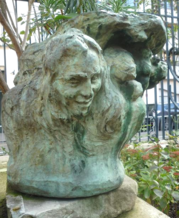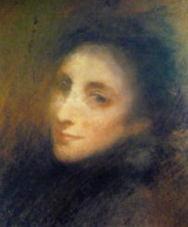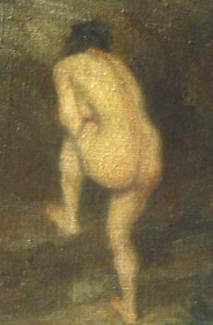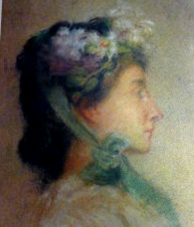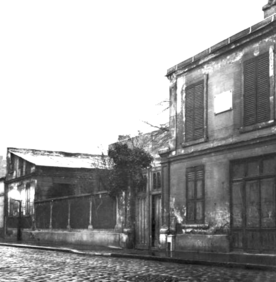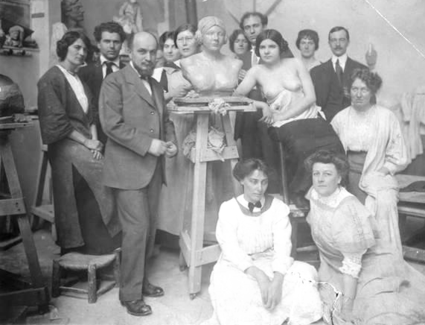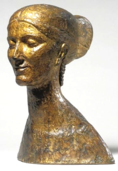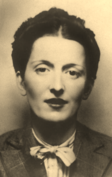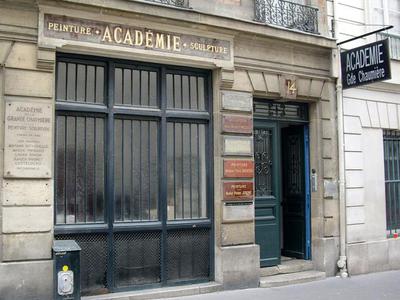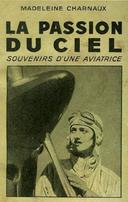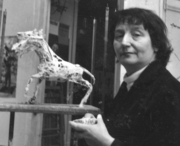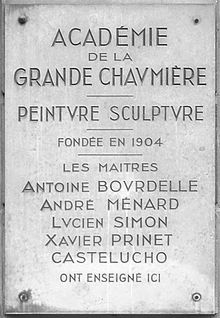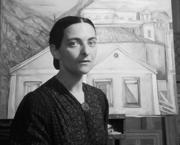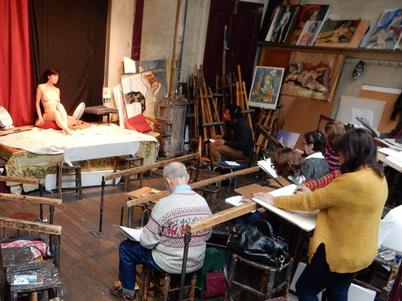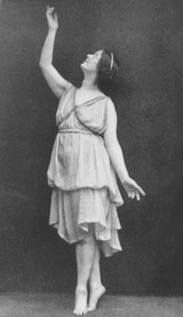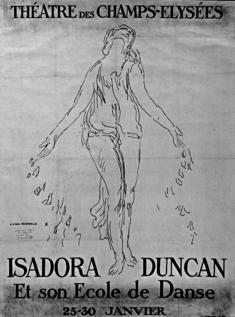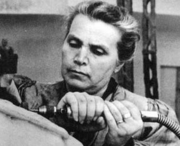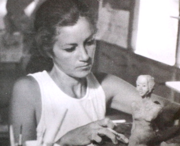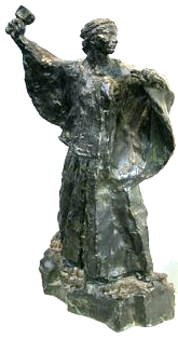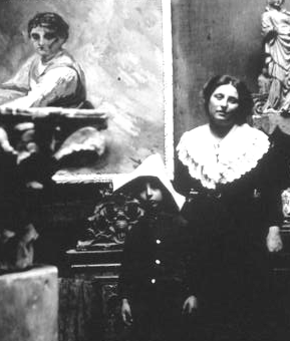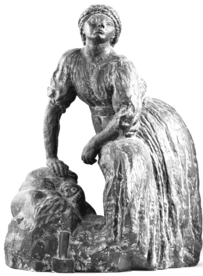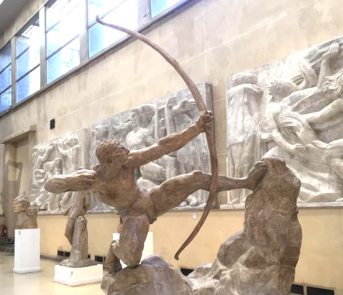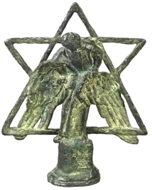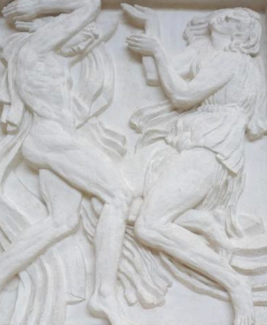Women's Travel Abroad
For Women About Women By Women
Destinations
In 1885 Antoine Bourdelle rented this property on 16 Impasse du Maine for his atalier. Twenty years after his death, in 1949, it was opened to the public as a free city museum of Paris. Two additional spaces, the terrace and hall, were added to exhibit some of his largest works.
The museum is located in the exact place it was more than a hundred years ago but the street has been renamed in his honor. I enter the museum at 18 Rue Antoine Bourdelle through a large lobby. There are restrooms to the left of me which, of course, I use before venturing forth. In this same space is a place to get my free ticket and collection of books about Bourdelle and other artists of his time. Most are in French but one is in English, Emile-Antoine Bourdelle by Michel Dufet and Ionel Jianou. The book is primarily a review of his art works and an analysis of his unique artistic style.
A small brochure provided by the museum gives me some details of his life. Emile-Antoine Bourdelle was born in 1861 at Montauban, France. He was born into a middle class family of artisans, craftsmen and designers. His mother was a weaver, his father a cabinet maker, and his uncle a stone cutter. As a child he tended sheep on the slopes of the Caucases mountains and molded creatures out of clay firing them in the same oven used to bake the family's daily bread. He showed a talent for drawing at a young age. His classroom teacher often let him draw while his fellow classmates did their lessons.
When he was thirteen years old he discontinued his academic studies and went to work as an apprentice wood carver in his father's shop. Here he learned the importance of completing a commissioned project. His experience of meeting client specifications and expectations ensured the family's economic well-being. No doubt these life lessons served him well in adulthood when he had his own studio to manage, commissions to complete, and family to maintain.
However, despite this tiring and time consuming day job, he did not abandon his artistic studies or desire to pursue a career as an artist. After working all day he took drawing classes in the evening at the Municipal School in Montauban. Working with Achille Bouis, a former photographer, he learned to model clay and copy ancient plaster figures.
He applied what he learned at the Municipal School to his wood carving. His artistry came to the attention of a local banker, Hyppolite Lacaze, and writer, Emile Pouvillon. In 1875, at the age of fourteen, he passed the entrance exam to the Toulouse School of Fine Arts. Lacaze and Pouvillon helped Bourdelle get a scholarship so he could continue studying.
During his nine years at the school Bourdelle modeled portraits of his teachers and patrons. Bourdelle finished his studies in Toulouse in 1884. He received a grant from the municipality of Montauban to continue his artistic work in Paris. That same year he was also admitted to the School of Fine Arts in Paris and signed up to study with the painter and sculpture Alexander Falguiere.
It is easy for me to imagine Falguiere, a Toulouse native son, and Bourdelle, recently arrived student from Toulouse, forming a long lasting relationship. However, after spending a brief time in Falguiere's workshop Bourdelle realized he was much further advanced than his fellow students. Also, the school's unending round of competitions did not suit Bourdelle's personality, work ethic, or artistic vision. He left the school and struck out on his own accepting private commissions and showing his work at galleries throughout Paris.
By 1885 Bourdelle had established his atelier at this location in Montparnasse. He rented the space for 500 Francs a year. At the time the property was surrounded by gardens, vine yards, and wheat fields. There were several other artist studios and antique shops in the area to visit for inspiration. Bourdelle was pleased with his quiet house. He felt it had a magnificent entrance hall, substantial sized rooms, and an ample number of windows.
Bourdelle lived and worked here until his death in 1929. It is thanks to his second wife, daughter, and son-in-law ( Cleopatra Bourdelle Sevastos, Rhodia and Michel Dufet ) and their enduring commitment to Bourdelle's dream of his atelier being open to the public that I am able to visit here today. From the museum's grand entry vestibule I proceed to a lush courtyard garden.
I find myself in the first of the three gardens in the atelier. Bourdelle, a country boy at heart, liked to visit them often for a restful break from work. Today the gardens are filled with many of his sculptures. In front of me is an inviting bench. I sit down, unpack my lunch, and admire his artwork.
Above me towers a huge classical sculpture of a horse. Nestled in the greenery beside me is a smaller art nouveau sculpture of three women. All around me are large art deco bas- relief sculptures. Bourdelle seems to like expressing his artistry by making three dimensional images in bronze. I marvel at his ability to work in so many different artistic styles.
Finishing my lunch I walk through the garden to the the entrance to the Bourdelle apartment. This is the first time I have visited the museum since it closed for renovations three years ago. The city of Paris is working on making their museums accessible to people with limited mobility. Now I see there is an elevator between the stairs going up to the second floor terrace and entry door to the Bourdelle apartment. I also see a friendly museum guard nearby who appears ready to anyone needing assistance.
The house where Bourdelle lived with his family actually has two stories but only one first floor room is open to the public. Of course, I wish more of the rooms. Earlier I noticed the outside of the house has been repainted from a pale pink I saw three years ago to soft yellow. Even at that visit it looked nothing like the photo taken in 1933. However, the last time I was here three years ago this room needed some updating.
This time I wonder if the color is what Bourdelle originally painted this room or if it is the trendy choice of a contemporary Parisian interior designer. It is impossible to tell from the black and white photograph. The curators probably took a color sample from the wall before they made their decision about what color to paint the walls. Personally I think it is a little too purple for the period. However, the color does brighten and warm up the room.
In 1886 Bourdelle brought his parents, grandmother, and aunt Rose to live in the atelier. His father set up a cabinet shop on the same street as the atelier. There are several drawings of his 'Grand Mere Bourdelle' and 'Tante Rose' in the room but no portraits of his mother. Sadly, she died a year after her move to Paris. Bourdelle was depressed after the loss of his mother and overcame his grief with his art.
Bourdelle used this room as a place for his family, friends, and clients to gather. The room is furnished with upholstered chairs, chaise lounge, writing desk, and curio cabinet. He displayed his personal collection of artifacts, sculptures, and paintings here. I see classical Greek busts, marble Roman columns, and ornate medieval pillars.
Over the head of the chaise are two self-portraits of him as a young man. In one painting he has painted himself in somber colors with soft but controlled brush strokes. The hat he wears gives me the impression Bourdelle would like me to see him as refined city dweller. The other portrait is painted with brighter colors in a more unrestrained manner. To me it suggests there is also a wild side to this rural born artist.
On the opposite wall are several drawings and paintings of the same lovely woman. In one pastel portrait her hat is decorated with a posy of colorful flowers. In the other she appears to be wearing no hat and the colors are somber and bleak There is are several oil paintings of her.
I wonder why there are so many drawings of this one particular woman, Madame Marie Leprade, in the room. My book tells me Bourdelle was hopelessly in love with her. Madame Leprade was a married woman. During his friendship with her Madame Leprade's husband died but her relationship with Bourdelle continued to be platonic. Apparently she did not haveromantic feelings for him. She refused his marriage proposal perhaps because she did not want to live the tenuous life of the wife of an aspiring artist.
It seems when Bourdelle first arrived in Paris many of his first commissions were from his patrons in Montauban or affluent Parisian men who wanted paintings of their wives or daughters. It was, at the time, the fashionable thing to do. As I look around the room I am enthralled with a grouping of enchanting pastel portraits. The way he drew these girls and women remind me of elusive little woodland sprites and fairies.
Then I see another wall full of even more lovely oil paintings of women. All of these women are dressed, head to toe, in elegant clothing of the period. Most of the women are painted outside in a natural setting. Comparing these pastels drawings to the oils painting I notice both seem to have one thing in common. All appear to be impressionistic in style.
Despite Bourdelle's ability to render images from life onto paper he never really felt drawing was his strong point. Instead Bourdelle decided to focus his artistic endeavors on sculpting. He justified his decision by saying "sculpture is just drawing in every direction." Bourdelle was so committed to the art form that in 1900 he, Auguste Rodin, and another friend of theirs opened a free sculpture school in the lively Montparnasse artist quarter.
From my previous visit I know the studio has two expansive rooms. Both rooms have windows from the floor to the ceiling. In the first room there is a large coal burning stove Bourdelle probably fired up during the cold winter months. High up on one wall is a collection of plaster busts, torsos, and statuettes. I wonder if he picked these up at his neighborhood antique stores or are they his creations? There are several cabinets in the room that Bourdelle may have used to store his tools and supplies. One cabinet is particularly ornate. Could he or his father have made this one? In front of that cabinet is a sculpture pedestal. The pedestal can be raised up or down depending on the artists height. Is it possible this was the stand that Bourdelle used when he worked on his smaller projects? There is a table and benches for working and seating. I am especially intrigued by three similar busts of the same woman. One bust is plaster and the other two are bronze. These busts, sculpted by Bourdelle, are of Madeline Charnaux. She was one of his students but left the artistic life in 1932 to be an 'aviatrice' and author. At the end of this room is a staircase that goes up to a second floor loft. Was this where Bourdelle had his office or a place where his assistants took their breaks. I really want to go up and take a look but the stairs are blocked off. On stands scattered throughout the room are more of Bourdelle's sculptures. Bourdelle seems to have liked sculpting figures. Some of them are real people like the sculpture of Gabriel Cognac as a young boy. Cognac was a supporter of Bourdelle and instrumental in funding the museum. He was nephew and heir of the owners of the Samaritine Department store in Paris. Also in this room is the sculpture Bourdelle did of himself when he was about sixty years old. Bourdelle often sculpted mythical characters. To the left is his full body statue of The Dying Centaur and on the right is the head and torso of the Greek goddess Pallas.
The second room has many of his smaller busts. However, since the renovation a video area with seating has been added. I take some time to watch the video about how Bourdelle would have made his sculptures. Another feature of this room is a collection of Bourdelle's sculpting tools. Also, more of his busts of people are on display here.
Rodin had seen Bourdelle's work exhibited at salons in Paris. In 1893 Rodin hired Bourdelle to work as an artist assistant in his own studio in 1893. While at Rodin's studio Bourdelle still continued to working on his own projects at this atelier. Bourdelle stopped working for Rodin in 1908 leaving the 'master of Meudon' employ on good terms.
During the eight years he spent with Rodin Bourdelle earned a reputation as a man who could design, create, and execute a project unlike Rodin who was often criticized for not completing one work before he started another. This garnered Bourdelle clients and commissions in the highly competitive world of sculptural art.
The Dying Centaur
Pallas
Gabriel Cognac
I leave Bourdelle's 'atelier de carriere' through the double doors that lead to even more gardens and sculptures. The amount of green space in this area is extensive considering the small space the atelier now occupies. This enclosed garden feels natural and informal. In some places tree branches obscure the statues or vines cover sculptures making it difficult to get good photos.
It seems obvious to me Bourdelle must have enjoyed spending time here. He added many architectural and decorative elements to the garden. He and I seem to share the same vision about how a garden should look. It reminds me of mine at home. I see the front of a classical Roman temple propped up against a plastered wall and a sculpture of a snake coiled around a pillar.
The snake makes me recall an interesting thing I read about Bourdelle. In Ionel Jianou and Michel Dufet's book about Bourdelle they related a story from his childhood. They say Bourdelle loved to visit his aunt Rose and grandmother at their house in Montauban. The house was owned by the director of the city's Natural History Museum.
The director's boa constrictor also resided at the house. It seems Bourdelle has captured his childhood memory of the snake and recreated it in a bigger than life sculpture. I am glad it is only a bronze replica and not the real thing. A snake this big would scare me out of my wits. There is no place to sit here so I continue to explore all of Bourdelle's wonderful sculptures.
Once again I am astonished by Bourdelle's talent to be able to express himself in so many different artistic styles. I wonder if this is what made him such an enduring artist. Early in Bourdelle's career his commissions came mostly from his sponsors and supporters in his home town of Montauban, His Monuments of the Fighters and Defenders of Tarn-et-Garrone of 1870 - 1871 was erected there in 1904. It took him nine years for this project to come to fruition. The monument can still be seen in Montauban today.
As time went by Bourdelle gained a reputation almost equal to Rodin. As a matter of fact, Rodin was one of Bourdelle's most vocal supporters. He spoke up against Boudelle's critics. Rodin praised Bourdelle's ability to create sculptures that went beyond conventional taste. He believed Bourdelle's passion for sculpting helped push the art form in a new direction.
janinetissot.fdaf.org
Bourdelle was active in many aspects of his art. Perhaps, one of Bourdelle's greatest contributions was his desire to share his knowledge and skills with other artists. When he was forty-eight years old he accepted a teaching position at the Grande Chaumierre Academy ( translated in English as the school of the great thatched roof) in Paris. The Academy was established in 1904 by the painter Claudio Castelucho. When Bourdelle joined the staff it was directed by three well known women painters; Martha Stettler and Alice Dannenberg.
During the time Bourdlle taught, The Academy offered sculpting and painting. It was referred to as a 'free school' because it did not have the strict academic rules about how art should be created. Students could freely express themselves artistically and experiment with many different styles of art. Teachers provided guidance, support, and insight. Anyone could attend classes, fees were very affordable. and did not need to be paid in advance.
Madeline Charnaux
Despite Bourdelle's critics he became a well sought after artist and received commissions from all over the world. In 1919 he was commissioned by Leon Vogt, a rich industrialist from Muhlhausen, to carve a statue of Mary and her child (The Virgin of the Offering). Vogt wanted to give the statue to Alsace, France.
Bourdelle's Mary holds her baby high in the air. Her eyes are looking downward rather than up. This makes it appear as if she already knows her child's fate and cannot bare to face it. Her baby son's arms are stretched outward in the Christian blessing but his pose also seems to portend his death on the cross. Her Roman garments give the statue a feeling of antiquity.
Bourdelle carved the statue out of a solid piece of stone that was almost twenty feet high. The statue was erected on a hill. His vision of the holy mother and child towers over the whole valley. Bourdelle sincerely felt this particular work reflected his belief that the order of a builder is "to contain, to maintain, and to master".
For me this work reflects my motherly feelings. Like Mary I know I too must let my babies go into the world to seek their own fate. Sadly, I when they leave I will no longer be able to keep them safe from harm... a reality difficult for me to accept.
Images.npg.org
Bourdelle completed his first version of Sappho in 1887. The original sculpture was just barely 1 foot high. He sculpted another version in 1924 that measured about 3 feet in height. The Sappho in the garden is nearly 8 feet high.
He received eight commissions for this monumental Sappho. Bourdelle sold reproductions of all his original works, large and small, to public and private buyers which made him a lot of money. Yet another lesson he may have learned from working in his father's workshop.
Sappho is the greatest female poet of antiquity. She wrote mostly love poems. In her time, the sixth century B.C., she would have recited them while playing a musical instrument like the lute. Looking at this sculpture
I wonder why Bourdelle's Sappho looks so introspective and joyless.
Bourdelle, like Sappho, was also a poet. He choose to wrote his verse in his native Occitan, the language of his region. Bourdelle claimed this 'patois' as his language for artistic expression and went so far as to say he even sculpted in the 'patois', his Provincial langue d'oc.
During Bourdelle's time there was a government sponsored movement to make langue d'eu the only language of France. Is Sappho pose showing us how Bourdelle felt about the loss of his regional language? There is a Sappho in Montauban but Occitan is not spoken there today.
Students came from all over the world to attend Bourdelle's classes at the Academy. Jianou and Dufet refer to him as "the maitre a penser of a whole generation: he helped his pupils to discover their own resources; he taught them fredom and boldness of invention, frankness, generosity, dedication, the discipline of artistic thought, and the ardent search for essential truths."
Bourdelle, on the other hand, simply referred to himself as the midwife of their souls. An appropriate description considering quite a few of his students were women. Many of them went on to become very successful painters and sculptors. He could easily claim to have helped with the birthing of their artistic careers.
Among his more famous students are four female artists. Maria-Helena Viera de Silva from Portugal studied sculpture with him during her teen years and went on to become a well-respected modernist painter. Angela Gregory was one of his favorite students and the first American to be admitted as a student in his private studio. His French student Germaine Richier worked as an assistant in his atelier from 1926 to 1929. The Russian born student Vera Mukhina returned to her home country to become the 'Queen' of realistic Russian Communist sculpture.
Bourdelle's students said the school provided them with a place to sit, a model to draw, and a stove to keep them warm. Amazingly the Academy of the Grande Chaumiere has operated continuously for over 100 years. The focus of the Academy is almost the same as it was in Bourdelle's day except sculpture classes are no longer offered. As you can see in the photos not much has changed since then. The original entrance is still the same, the stove is still in the studio, students still sit on stools, and there is still a model to draw.
Painting and drawing classes are open to anyone at a relatively low cost. There are informal drawing workshops and formal classes. Formal classes taught by French speaking master artists are more expensive. You can sign up to attend a semester long fee-based class or buy an individual attendance punch card to drop in on a workshop. You can check their website for classes and exhibits.
It surprised me to learn Bourdelle used unclothed models in his mixed gender class at the Academy. There was a nude model in my mixed gender life drawing class at the university it never occurred to me the women students in his class would have the same experience as I did in the twenty-first century. I always thought at this time in history only male artists employed female nude models in their private studios.
cocottemin.fr
f.i.uoi.br
gallica.bnf.fr
mccarthyjensensculpture.com
Top: Viera da Silvia
Bottom: Angela Gregory
Top: Germaine Richier
Bottom: Vera Mukhina
1.bp.blogspot.com
Bourdelle also used models in his private studio. Although judging from the many sculptures he did of women most were fully clothed. One of his favorite models was the American dancer Isadora Duncan. Bourdelle met Duncan in 1903 at Vezily, France where she danced at a garden party given to honor Rodin. Rodin immediately became enamored with her and claimed her as his muse.
Six years later Bourdelle saw Isadora dance onstage at the Theatre du Chatelet for the first time. He was so intrigued by Isadora that the very next day, drawing from his memories of the previous evening, he filled an entire notebook with sketches of her. From then on Bourdelle frequently went to the theater and drew Isadora while she performed.
The combination of her naturalistic dance style and classical Greek costumes seems to have appealed to his personal aesthetic. Lori Belilove (Isadora Duncan Dance Foundation) says that Isadora "was determined to dance a different dance based on the discovery of the classical principles of beauty, motion, and form." Duncan viewed dance as a way to tell her life story through abstract conceptualization and universal themes.
In 1914 Isadora established a dance school, the Dionysian, in a mansion in the Paris suburb of Belleville. Perhaps the poster from a performance she gave at the Theatre des Champs-Elysees with her dance school students dates from that time. If so it is certain Bourdelle had an enduring friendship with Isadora. He did the drawing of Duncan on the poster.
Isadora was Bourdelle's inspiration for many of his marble bas-relief friezes for the Theatre des Champs-Elysees. The most well known of these is La Danse installed in 1913 above the entry doors. Bourdelle said he used Isadora for all his friezes of the muses he did for the theater. Bourdelle seems to have used this very public venue to claim Isadora as his personal muse.
The Theatre des Champs-Elysees is the same theater where she performed with her dance students while she lived in Paris. Perhaps Isadora's performance was her tribute to Bourdelle. His sculptures left a lasting record of her contribution to the art of dance. She closed her school in 1917 and left Paris but her image can still be seen today on the Theatre des Champs-Elysees.
Sadly, Bourdelle's muse died a tragic death in Nice, France on September 14, 1927. Isadora's scarf got caught in the spokes of a moving car tire breaking her neck. The next time Bourdelle may have seen Isadora was at her funeral. Like Bourdelle the French people claimed her as their own. She is one of the few American women buried at Pere LaChaise Cemetery in Paris.
Women were an important part of Bourdelle's life. They were his models, mistresses, and muses. It is believed he had illicit affairs. Working with his female assistants and students probably gave Burdelle many chances to engage in romantic liaisons. Bourdelle was reputed to be attractive, intelligent, and charismatic. Women seem to have found him appealing. Stephanie and Bourdelle had a difficult married life. It is possible her jealousy over his affairs might have caused conflicts in their marriage. In 1910 the couple separated and divorced. Pierre lived with her from then on.
A year later Bourdelle and Cleopatra Sevastos had a daughter named Rhodia. She and her sister had been his students. Museum records state Cleopatra modeled for him in the atelier and traveled with him to London in 1905. A family photograph shows Stephanie and Cleopatra smiling at each other. Pierre is seated at his mothers feet. Two other women are also in the photo. The standing woman might be Aunt Rose and the seated woman may be Cleopatra's older sister. Bourdelle's Hercules statue is on the pedestal. He is behind Cleopatra gazing sheepishly at his wife.
In this photograph Pierre appears to be about five or six years old. The photo was taken sometime in 1907. Bourdelle and Stephanie dissolved their relationship three years later when Pierre was nine years old. It is obvious to me Stephanie knew Cleopatra several years before the divorce. What I am not sure of is whether Bourdelle and Cleopatra were having an affair at the time. It is possible it started at a later date. If they were romantically involved did Stephanie know about it?
Cleopatra Sevastos was born in Athens, Greece on December 17, 1882. She had a classical education, could read and speak several languages (Greek, French, and English), and was well traveled. Cleopatra was also an excellent student and had artistic talent. Boudelle's statuette of Cleopatra (Sculptress at Work, 1905) portrays her as a young, powerful, and focused sculptress.
Stephanie and
Pierre
Bourdelle
and
Cleopatra
Stephanie and
Pierre
Bourdelle
Cleopatra
and
Rhodia
After the birth of her daughter Cleopatra gave up her artistic career. She dedicated the rest of her life to caring for Bourdelle and Rhodia. Cleopatra and Bourdelle married in London in 1912. They were officially married by French law six years later in 1918 at the Paris suburb of Saint Cloud. They remained married until Bourdelle's death.
By 1918 Bourdelle's grandmother, mother, father, and aunt had died. His business had expanded into a very successful enterprise. He had many production workshops along the Rue du Maine, employed lots of assistants, and taught several students in his atelier studio. He needed a wife like Cleopatra to help him manage his personal and professional life. She continued to be model for him, meet with clients to discuss the details of projects, oversee the every day operations of the atelier, and entertain his artistic friends.
Bourdelle loved both of his children dearly. He was a devoted, tender, and playful father. He welcomed Pierre and Rhodia when they visited him in the studio. Bourdelle painted pictures and made sculptures of the children. He affectionately called his little daughter Amourette or Pouchette, carved small statues of her, and dedicated poems to her. I wonder if the fairy-like Amourette statue in the garden is the embodiment of Bourdelle's adoration for Rhodia.
Bourdelle found her marvelous, writing about her in his diary, "the morning clouds darken her tiny face which shines behind, in spite of them, with rogus grace. She adds spirit to the sparkle of the morning dew. One seems to see the budding soul and everything in the world belonging to the hours of dawn attend the child's awakening. Art means restraining one's heart, but is it not more wonderful when our hearts have trembled?"
As I was entering the front garden of the museum I saw one of my favorite art works by Bourdelle. I had seen Penelope on my last visit and became completely enthralled by her. Penelope is the main character in Homer's Odyssey. Bourdelle choose to sculpt his Penelope as an intellectually thoughtful and physically strong woman. The sheer mass and size of this sculpture makes me think Bourdelle had a lot of respect for Odysseus's devoted and loyal wife.
In the ancient Greek story Penelope faithfully waits for her husband Ulysses to come back from the Trojan Wars. While he was gone Penelope successfully ruled their estate and duped every man who wanted to marry her. Penelope told each of them she would choose a new husband when she finished her weaving project. However, every evening she would undo her weaving and begin weaving the fabric anew every morning. This ruse went on for ten years until Ulysses returned home to claim his throne and wife.
Bourdelle began working on his bronze statue of Penelope in 1905. He developed his Penelope in four stages over a period of seven years. He shaped the first original small statue of Penelope holding a spindle. The second small statue was modeled in 1907 with no spindle. A third statue, built in 1909, was about twice as large as the small version. In 1919 Bourdelle exhibited his monumental Penelope at the Salon de la Society Nationale des Beau Arts.
During the time Bourdelle worked on Penelope major changes were taking place in his private life. In 1905 he traveled to London with Cleopatra leaving his wife and son in Paris. It is generally believed this trip marks the beginning of their amorous relationship. If this is true then he was having an affair with Cleopatra for the entire time it took for him to complete all his versions of Penelope. Did his Stephanie know what was going on between them for all those years before she filed for divorce?
After Bourdelle's death his daughter said Penelope was a synthesis of his two wives. The sculpture was made from a drawing of Cleopatra he did when the couple visited London. To keep peace in the family Bourdelle changed the original face features to resemble Stephanie. This time when I look at the statue I notice a faint reflection in the glass behind the sculpture. Is this Penelope confirming my suspicions that Stephanie knew this sculpture signaled Bourdelle was amorously involved with Cleopatra? After all it was Bourdelle who famously said "the secret of art is love."
The last area I visit is the grand Monuments Hall. It was opened in 1961 to commemorate Bourdelle's centary. The hall contains both originals and reproductions of some of Bourdelle's sculptures. Many of his largest sculptures are still permanently mounted and cannot be removed from their locations. However, the museum has replicated some for display here.
Bourdelle was commissioned to create many monumental statues of heroic men and women. Yet, with every sculptural composition he seems to have the ability to show us both their strength and weaknesses. He sculpted a naked, muscular Heracles the Archer (1909) at the very moment he releases his arrow, the death throes of The Dying Centaur (1911), and a hat free General Alevar (1912 -1915) mounted on his horse. I feel Bourdelle captures a breath-taking moment in history at the same time reminding me heroes are human too.
He continued working in the atelier during the first part of World War I (1914 - 1918). Bourdelle refused to leave the city even though Paris was being bombed by the Germans. He stayed in the city until the end of 1916 to finish work on his statue Victory. He said this sculpture was his way of fighting the war.
In 1918 Bourdelle returned to Paris and completed two more statues ( Liberty and Force ) as a tribute to the patriots who fought and served in the war. Many more projects, awards, and honors were to come his way over the next ten years of his life. Earlier in his life he was made a knight of he Legion of Honor. In 1919 he was promoted to an officer of the Legion of Honor and by 1924 he was the president.
During Bourdelle's lifetime his works were shown at major salons and galleries in France, Belguim, the United States, and Japan. He traveled to England, Germany, Italy, and Argentina to work on small projects and huge installations. He was well respected and admired world wide but his closest life long friends and supporters were the Parisian artists Astride Maillot, Ossip Zadkine, Henri Matisse, and Alberto Giacometti.
Bourdelle was admired by many Parisian artists and French political leaders for his indomitable spirit and and artistic boldness. He continued teaching students at the Academy of the Grande Chaumiere sharing humanistic and visionary approach to art until his death. He died on October 1, 1929 in Le Visenet, France at the home of his friend Eugene Rudier. He was interred at Montparnasse Cemetery.
Andre Saures said, "No one could possibly be more generous than Bourdelle. That is how he has been to all those who have needed him. He never waited for a call for help, he always went half-way to meet it. According to Ionel Jianou, "This generosity and eagerness to anticipate can also be found in his art. He anticipated the great revival of modern art, and by his deliberate boldness, opened up unexpected horizons."
His generosity extended so far as to include me and all the other people who are able to attend this museum for free compliments of the city of Paris. In the last few hours I have had the opportunity to explore the home, workshop, and gardens of one of Frances greatest artists. I am just one of the grateful others who have been touched by his artistic genius. My thanks for this experience must go to his wife Cleopatra and daughter Rhodia. Both of them were instrumental in fulfilling his dream of turning the atelier into a public museum. They convinced Gabriel Cognac to buy the atelier buildings and gardens in 1930. Cleopatra and Rhodia continued to live in the apartment while they solicited the city of Paris and individual suporters for additional funding. Cleopatra and Rhodia opened the Bourdelles Museum to the public on July 4, 1949.
General Alvar, Victory, Force
Heracles the Archer
The Dying Centaur
Bust of Stephanie van Parys, 1907
Cleopatra, Sculptress Resting, 1905 - 1908
Penelope, 1905 - 1912
Self-Portrait, Bourdelle, 1861 - 1929
Bourdelle and Cleopatra, 1920
It took them almost twenty years to fulfill Bourdelle's dream and create their own legacy of artistic enlightenment. Preparing for the opening of this museum was a huge task. Rhodia spent many hours organizing, documenting, and publishing Bourdelle's works. Cleopatra and Rhodia helped put on more than 300 exhibits of his art that exposed Bourdelle's idea of universal harmony to the world. Once the museum was opened it flourished and grew in size. In 1961 Henri Gautruche created the 'Plaster Room' to save and show Bourdelle's large sculptures and friezes. Rhodia was appointed to the position of curator in 1971. In 1992 Christian de Portzamparc built another extension. This museum has 500 of Bourdelle's masterpieces plus his personal collection of antiquities and the art of Rodin, Ingres, Delacroix.
Bourdelle's bust of himself shows me a humble man bowing his head in a prayerful manner. His iconic monogram reminds me of his family origins...his father's carpenter mallet, his uncle's stone cutter chisel, and a compass that would have been used by all of them to determine correct proportions. It seems that Bourdelle always remembers to pay homage to the past and give thanks for the future.
In 1979 Jianou wrote, "Bourdelle's work offers the example of an art which unites instinct with reason, intuition with knowledge, fantasy with order, freedom with method, and fervor with meditation." I am inclined to believe it is Bourdelle's ability to visually join all these opposing concepts that makes his art so appealing to me. He uses every artistic technique he knows to engage and intrigue me. I always want to see more.
If for some reason you cannot visit this wonderful museum there are other places to see his work. There is a second garden museum in Egreville, France established by his heirs. His works can also be seen at museums in Paris. A small version of Bourdelle's Three Apples can be seen at the Petit Palais. A bronze cast of Heracles the Archer is on display at the d'Orsay Museum.
Victory, 1945
Riverside Entrance
City Museum of Modern Art
La Dance, 1910 - 1913
Isadora and Nijinsky
Theatre des Champs-Elysses
Joan of Arc, 1909
The Chapel of
Saint Joan of Arc
Bourdelle's portfolio of art is huge. This time I saw some pieces of his work that were not displayed the first time I visited. Also, the art gets moved from place to place and may not be where you expect it if you have been here before. During my visit I have an opportunity to view photographs from the Bourdelle family album, see a video about how to make a bronze sculpture, and see Bourdelle's tools. All in all it has been a most interesting day.
The English version of the museum brochure informs me it offers a wide variety of cultural and educational activities, including modeling and drawing workshops, story-telling, and conferences. I suspect they are offered in French. In the Eugene Carrier Workshop visitors can actually touch selected tools, materials, and works on display. From time to time the museum mounts temporary exhibits and and there is usually a fee for admission. The museum's website posts upcoming activities and events.
You Are Welcome to Contact Me Personally With Comments or Questions
Copyright 2017 Creative Travel Publications, LLC
A year after opening the free sculpture school Bourdelle became a father. In 1901 he and Stephanie van Parys had a son named Pierre. It is a mystery to me just exactly where how the two of them met. It could not have been at a cafe or salon. Bourdelle never visited either. Maybe the French Flanders born mother of his son had attended art classes at his free sculpture school. However, there seems to be no art by her in the museum. Perhaps, she was a model in Rodin's studio or Bourdelle hired her as his model.
Bourdelle was thirty nine years old when he married Stephanie in 1904. It is unclear when she began living in the apartment with him but a photograph of her posing nude with her foot up on the chaise suggests she was not pregnant when she moved in with them. There is an oil painting of her hung in the apartment in this pose and a photograph in the family album of a sculpture of her in a similar pose. So it does appear she had modeled for him sometime during their relationship.
Leaving the apartment I walk through an arched walkway and see the sign for the Atelier De Carriere. It is in this studio I will get a glimpse into the artistry of this amazing man. This is the very place where Bourdelle and his assistants worked to create his masterpieces. I enter the 'atelier de carriere' through a heavy wooden door.
